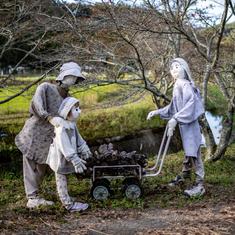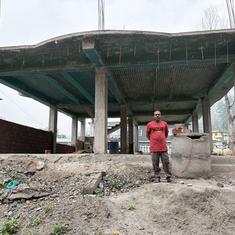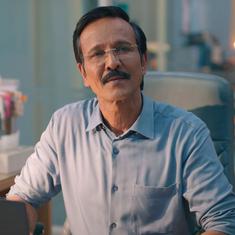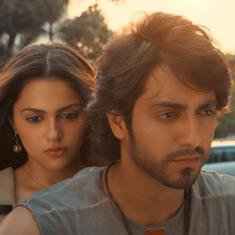In the late 1980s, I had the privilege of meeting Raj Khosla. I was introduced to him by Guru Dutt’s sister, the artist Lalitha Lajmi, who took me to see him in Marina Apartments in Pali Hill in Bandra, Mumbai. His apartment was later bought by Aamir Khan’s family, and it is where they still live today.
At that time, I was researching material for a documentary I later made called In Search of Guru Dutt (Channel 4 TV, UK, 1989) and meeting Raj Khosla was most memorable. His love for cinema, warmth of personality and generosity of heart were so evident.
Following are excerpts from two conversations, the first an audio interview recorded on November 5, 1986, and the second filmed on September 22, 1988.
Raj Khosla: In those days [late 1940s, early 1950s], I wanted to be a playback singer. Dev [Anand] was trying to help me, but things weren’t working out. So, one day he told me, “There’s a friend of mine, Guru Dutt, and he’s going to direct my next picture. Why don’t you become his assistant?”
“I don’t want to do filmmaking; I want to sing.”
He said, “Come on! Get together, things will gradually fall into place.”
That’s how I met Guru Dutt. He asked me, “Do you have any experience in being an assistant in films? Dev has recommended you.”
“Yes, I have, I’m studying filmmaking.”
The second thing he asks, “Do you know Hindi?”
“Of course I know Hindi.”
I didn’t write in Hindi. I wrote in Urdu and Persian. In the 1940s, most Punjabis knew Urdu well, and some, even Farsi. But I didn’t know how to write in Devanagari. He said, “Fine, join duty from tomorrow.”
So I ran from there and the first thing I did was learn to read Hindi, ka, kha, ga. Sure enough, after six or seven days, he said, “Just copy out these scenes.” By that time, I had picked up some Hindi. When I wrote the scenes, he asked, “One second, when did you start learning?”
I said, “The day you asked me if I knew Hindi.” He smiled. We struck up a friendship instantly.
Nasreen Munni Kabir: What was your relationship with the Anands?
Raj Khosla: The Anand family and my family were from the Punjab. We had generational relations. Their father and mine were college mates and friends. So, we were the second generation of friends.
When I was looking to work, Chetan Anand said, “Why don’t you work at Navketan?” Since they were producing Baazi at that time, my destiny was kind to me. I opted to work as Guru Dutt’s assistant.
Nasreen Munni Kabir: You told me you were very fond of Sahir Ludhianvi.
Raj Khosla: I was a college student when I heard the work of Sahir sahab. I told my father that Sahir Ludhianvi was going to be a fantastic success.
In my college days, I used to know a poem written by Sahir, Sanaa-khvaan-e taqdis-e mashriq kahaan hain. This poem became Jinhen naaz hai hind par woh kahaan hain. The lines were changed for Pyaasa, because who would understand the Persianised original lines?
One day we were sitting in the Navketan office, and I sang the whole song to Guru Dutt. I had composed the tune myself, and he said, “Raj, this is it! This is Pyaasa!” By chance, Sahir was already writing for him in Baazi. So, there was no problem of copyright or anything.
Guru Dutt had a great gift of understanding emotion. But the relationship between Sahir and Guru Dutt was a little distant, I would say. In art, they were very close but personally they were not very close. I was personally much closer to Sahir.
Nasreen Munni Kabir: You said you wanted to be a singer. Did you record any songs?
RK: No, I didn’t. In Jaal, we had this song, Sun Ja Dil Ki Dastaan. Guru Dutt recorded me singing it, but I failed the test. SD Burman said, “Raj is good, but...” The song was later re-recorded in Hemant Kumar’s voice. It was a tremendous hit.
Nasreen Munni Kabir: Can we talk about your first film as director? And then C.I.D.
Raj Khosla: My first film was Milap, I made it for the same producer, TR Fatehchand, who also made Jaal.
Many people thought C.I. D. was my first film, because Milap was not a hit. It was C.I.D. that got me noticed as a director.
There’s an amusing incident that happened when C.I.D. was released in Calcutta in 1957. We had very heavy rains that year and all the flights were cancelled, so we went to Calcutta by train. We took a box of beer and drank in the compartment. Remember Bombay-Calcutta was 46 hours in those days.
We got thoroughly bored with each other. As the train ultimately entered the train station, the distributor, who was a very fat man, I don’t remember his name, had garlands ready for us and he said, “Raj, it’s a hit. Ho gaya kaam!” (The work is done!)
The garlands told us things were okay. Nevertheless, we went to the theatre to see for ourselves how C.I.D. was doing. Twenty minutes into the film, Guru Dutt says, “Raj, you’ve made a super-hit film, come on, let’s celebrate.”
The next morning, I didn’t find him in the hotel suite. I searched everywhere for him. Where is he? Fully dressed, with bowtie and all, lying in the bathtub. He must have been drinking all night. He was very sweet.
Nasreen Munni Kabir: Why didn’t you carry on directing under Guru Dutt’s banner?
Raj Khosla: As a matter of fact, after C. I. D., he offered me a lakh of rupees for the next film, which was a lot of money in 1957. I said, “No, Guru Dutt, I will not work with you anymore.”
“Why? What’s the problem?”
“You don’t grow under a big tree. I’m a small plant. If I work with you, it’ll always be Guru Dutt made this film.” He said, “Go your way. Whenever you want to come and make a film for me...”
Nasreen Munni Kabir: Can you talk about the C.I.D. song Leke Pehla Pehla Pyaar, featuring Dev Anand and Shakila? It was filmed on the pedestrian promenade on the Worli Sea Face [now part of the Coastal Road].
Raj Khosla: Dev Anand was a very disciplined person. He still is one of the most disciplined actors we ever had.
The only thing I remember about that song is that Dev Anand tells me, “Raj, what am I doing in this song?”
“The song is doing everything, you just walk.”
So we started shooting. It was quite a long walk down the promenade, you know. The song goes through its entirety for about three minutes or so and he keeps walking. So after a few shots, he said, “You want me to walk a mile or two or something? What am I doing in this song?” I said, “You’re walking. You’re not going to sing.”
“Okay, you’re the boss.” Typical of Dev, you know, he always wants to be active.
Then the second thing I remembered is that while walking he had this habit of always using his hands somewhere. “You don’t move your hands.”
He says, “I can’t sing, I can’t move my hands, I’m supposed to walk.”
“That’s it, you’re just supposed to walk and look handsome!”
Also read:
In Raj Khosla biography, a portrait of a director as a ‘gloriously flawed human being’
When Dharmendra saved a village from dacoits before ‘Sholay’










